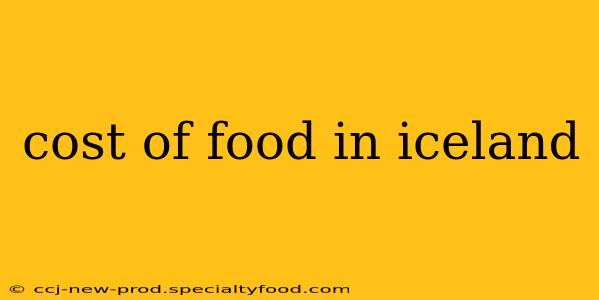Iceland, a land of fire and ice, also boasts a surprisingly high cost of living, and food is no exception. Planning a trip or considering relocation? Understanding the price of groceries and eating out in Iceland is crucial for budgeting effectively. This guide dives deep into the factors influencing food costs, providing you with a realistic picture and practical tips to manage your expenses.
What Factors Contribute to Iceland's High Food Prices?
Iceland's high food prices are a complex issue stemming from several interconnected factors:
- Geographic Isolation: Being an island nation, Iceland relies heavily on imports for a significant portion of its food supply. Transportation costs significantly inflate prices.
- Limited Agricultural Production: The harsh climate restricts the types and quantities of food that can be grown domestically. This dependence on imports further exacerbates costs.
- Strong Icelandic Króna (ISK): While fluctuations occur, the ISK's strength against other currencies can sometimes impact import costs.
- High Labor Costs: Wages in Iceland are generally high, impacting the cost of production and service across various sectors, including the food industry.
- Value Added Tax (VAT): Iceland's VAT adds to the overall cost of goods, including food items.
- Import Tariffs and Duties: Taxes on imported food products contribute to their higher retail prices.
How Much Does Groceries Cost in Iceland?
Estimating the precise cost of groceries is challenging as it varies depending on your diet and shopping habits. However, you can expect to pay significantly more than in many other European countries. A weekly grocery bill for a single person could easily range from ISK 15,000 to ISK 30,000 (approximately $100 to $200 USD), depending on choices. A family's grocery bill would, naturally, be considerably higher.
What are some affordable options for groceries in Iceland?
- Discount Supermarkets: Stores like Bonus and Krónan offer more budget-friendly options compared to more upscale supermarkets.
- Buying in Bulk: Purchasing larger quantities can sometimes lead to savings, especially for staple items.
- Local Farmers Markets: Seasonal produce at farmers markets can sometimes be more affordable than supermarket options.
- Cooking at Home: Preparing meals at home is considerably cheaper than eating out regularly.
How Much Does Eating Out Cost in Iceland?
Dining out in Iceland can be a significant expense. A casual meal at a local restaurant might cost ISK 3,000 to ISK 5,000 per person (approximately $20 to $35 USD), while a more upscale dining experience could easily exceed ISK 10,000 per person.
Are there cheaper options for eating out in Iceland?
- Street Food: Hot dogs and other street food options are relatively inexpensive.
- Cafes and Bakeries: Sandwiches and pastries at cafes can provide a more budget-friendly alternative to full restaurant meals.
- Happy Hour Specials: Many restaurants offer happy hour deals on drinks and food.
- Self-Catering: Utilize your accommodation's kitchen facilities to prepare some meals yourself.
Is Food in Iceland Worth the Price?
The quality of Icelandic ingredients is generally high, and the country has a rich culinary tradition. You'll find fresh seafood, lamb, and dairy products that are often locally sourced. Whether the cost is "worth it" is subjective and depends on your budget and priorities. For many, the unique culinary experiences Iceland offers justify the higher cost, while others may need to be more mindful of their spending.
What are some tips for saving money on food in Iceland?
- Plan your meals: Creating a weekly meal plan can help you avoid impulse purchases and stick to your budget.
- Pack snacks and drinks: Bringing your snacks and drinks can save you money on impulse purchases while sightseeing.
- Take advantage of free activities: Many of Iceland's most stunning attractions are free, allowing you to allocate more of your budget to other necessities.
- Look for deals and discounts: Check for discounts and special offers at restaurants and supermarkets.
This comprehensive guide should provide you with a clear understanding of the cost of food in Iceland. Remember, diligent planning and smart budgeting can help you manage expenses effectively and enjoy the unique culinary experiences this beautiful country offers.
